- Home
- About
- Map
- Trips
- Bringing Boat West
- Migration West
- Solo Motorcycle Ride
- Final Family XC Trip
- Colorado Rockies
- Graduates' XC Trip
- Yosemite & Nevada
- Colorado & Utah
- Best of Utah
- Southern Loop
- Pacific Northwest
- Northern Loop
- Los Angeles to NYC
- East Coast Trips
- 1 Week in Quebec
- Southeast Coast
- NH Backpacking
- Martha's Vineyard
- Canadian Maritimes
- Ocracoke Island
- Edisto Island
- First Landing '02
- Hunting Island '02
- Stowe in Winter
- Hunting Island '01
- Lake Placid
- Chesapeake
- Provincetown
- Hunting Island '00
- Acadia in Winter
- Boston Suburbs
- Niagara Falls
- First Landing '99
- Cape Hatteras
- West Coast Trips
- Utah Off-Roading
- Maui
- Mojave 4WD Course
- Colorado River Rafting
- Bishop & Death Valley
- Kauai
- Yosemite Fall
- Utah Off-Road
- Lost Coast
- Yosemite Valley
- Arizona and New Mexico
- Pescadero & Capitola
- Bishop & Death Valley
- San Diego, Anza Borrego, Joshua Tree
- Carmel
- Death Valley in Fall
- Yosemite in the Fall
- Pacific Northwest
- Utah Off-Roading
- Southern CA Deserts
- Yosemite & Covid
- Lake Powell Covid
- Eastern Sierra & Covid
- Bishop & Death Valley
- Central & SE Oregon
- Mojave Road
- Eastern Sierra
- Trinity Alps
- Tuolumne Meadows
- Lake Powell Boating
- Eastern Sierra
- Yosemite Winter
- Hawaii
- 4WD Eastern Sierra
- 4WD Death Valley +
- Southern CA Deserts
- Christmas in Tahoe
- Yosemite & Pinnacles
- Totality
- Yosemite & Sierra
- Yosemite Christmas
- Yosemite, San Diego
- Yosemite & North CA
- Seattle to Sierra
- Southwest Deserts
- Yosemite & Sierra
- Pacific Northwest
- Yosemite & South CA
- Pacific Northwest
- Northern California
- Southern Alaska
- Vancouver Island
- International Trips
- Index
- Tips
- Books
- Photos/Videos
- Search
- Contact
Bishop, CA
Friday, September 27, 2019 - 10:15am by Lolo
360 miles and 7 hours from our last stop - 5 night stay
Travelogue
Day 1 - Hike from South Lake to Long Lake plus Chocolate Lakes
 Along the South Lake to Long Lake to Chocolate Lakes TrailIt was so cute. Andrew and Celeste were so excited to show us all the great hikes they had discovered since living in Bishop. One of their favorites is the hike from South Lake to Long Lake, which they said was so beautiful that the first time they did it, it took their breath away. Sounded good to me.
Along the South Lake to Long Lake to Chocolate Lakes TrailIt was so cute. Andrew and Celeste were so excited to show us all the great hikes they had discovered since living in Bishop. One of their favorites is the hike from South Lake to Long Lake, which they said was so beautiful that the first time they did it, it took their breath away. Sounded good to me.
Even before we got to the trailhead, we were blown away by the drive along South Lake Road, where the sun shining through the ominous clouds dramatically lit up the bright yellow aspens alongside the road. If this was a prelude to what was to come, this was going to be a pretty awesome day.
The trail to Long Lake starts at the end of South Lake Road (elevation (9,800) and climbs steadily uphill along the eastern shore of lovely South Lake. At .75 mile, we mistakenly took a right at a junction and followed a trail that continued along the lake. After about a half mile, Andrew realized that this didn’t look like the hike he had done before, so we retraced our steps back to the junction and hung a left instead.
 Along the South Lake to Long Lake to Chocolate Lakes TrailBack on the right trail, we continued climbing steadily up until after about 3 miles we reached Long Lake, another stunningly beautiful alpine lake at 10,760 elevation - so we had climbed about 1,000 feet already.
Along the South Lake to Long Lake to Chocolate Lakes TrailBack on the right trail, we continued climbing steadily up until after about 3 miles we reached Long Lake, another stunningly beautiful alpine lake at 10,760 elevation - so we had climbed about 1,000 feet already.
From here, rather than returning, we collectively decided to add on the Chocolate Lakes Loop, which circled Chocolate Peak and passed another four beautiful small lakes. The trail was steep and quite rocky. It was also much less traveled and well marked, so we did get a bit confused at times and had to do a bit of bushwhacking, but nothing major. At 4.5 miles we reached our highest point of about 11,500 feet.
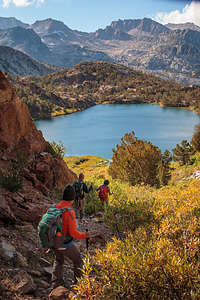 Along the South Lake to Long Lake to Chocolate Lakes TrailNot sure about the others, but I was beginning to feel the altitude a bit. After all, we were practically at sea level when we left Santa Rosa yesterday. Also, I never seem to drink enough water, which would have helped.
Along the South Lake to Long Lake to Chocolate Lakes TrailNot sure about the others, but I was beginning to feel the altitude a bit. After all, we were practically at sea level when we left Santa Rosa yesterday. Also, I never seem to drink enough water, which would have helped.
After all that work going uphill, I never really got to enjoy the downhill, as rocky trails are always tough going down on, and I was beginning to get a headache, which I assume was from the altitude. Eventually, my legs got a bit wobbly as well and I looked and felt a little drunk, without the benefit of actually drinking. Needless to say, I was very happy to see the parking lot again.
I didn’t say much to anyone at the time that I wasn’t feeling well, because I thought it would pass now that we were down to a more reasonable altitude. However, it got increasingly worse as we drove back to Andrew and Celeste’s. I told everyone that I just needed an Ibuprofen and a 20 minute nap, but I wound up getting nauseous as well and stayed in bed right through dinner.
This very unpleasant experience has made me gain an entirely new respect for the effects of altitude. I vowed that from this point forward I would try to be smarter in terms acclimating and drinking water at high altitudes.
Day 2 - Climbing at the Buttermilks and dinner in Mammoth Lakes
 Herb hits Buttermilk Road on Andrew's Kawasaki KLX 250The main reason Andrew and Celeste moved to Bishop is their passion for rock climbing. Bishop is blessed with perfect climbing conditions. Not only is the climate perfect for climbing with only 6" average annual rainfall, and over 300 days of sunshine, but the crags and boulders that surround the town are world class.
Herb hits Buttermilk Road on Andrew's Kawasaki KLX 250The main reason Andrew and Celeste moved to Bishop is their passion for rock climbing. Bishop is blessed with perfect climbing conditions. Not only is the climate perfect for climbing with only 6" average annual rainfall, and over 300 days of sunshine, but the crags and boulders that surround the town are world class.
Today Andrew and Celeste wanted to take us to their favorite climbing area, the Buttermilks, one of California’s premier bouldering destinations. It’s located just a half hour from their apartment, out along the bumpy, washboard Buttermilk Road.
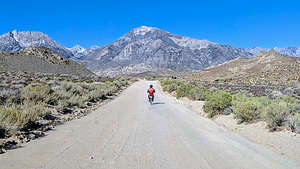 Herb hits Buttermilk Road on Andrew's Kawasaki KLX 250Andrew had recently bought a Kawasaki KLX 250 off-road motorcycle and had taken it on a 30-mile bumpy, rocky ride along the Buttermilk Loop a few weeks ago. He said it was quite exciting, as well as a bit scary. Herb had always dreamed of off-road motorcycling in his younger days, so Andrew offered to let him ride his bike out to the Buttermilks - not the whole loop, but just the 5 miles or so to the bouldering area.
Herb hits Buttermilk Road on Andrew's Kawasaki KLX 250Andrew had recently bought a Kawasaki KLX 250 off-road motorcycle and had taken it on a 30-mile bumpy, rocky ride along the Buttermilk Loop a few weeks ago. He said it was quite exciting, as well as a bit scary. Herb had always dreamed of off-road motorcycling in his younger days, so Andrew offered to let him ride his bike out to the Buttermilks - not the whole loop, but just the 5 miles or so to the bouldering area.
Andrew and I followed behind him in the 4Runner. We could see that the bike was fishtailing quite a bit in the soft sand, which must have been a bit disconcerting for someone that has only ridden on asphalt. When we got to the end, Herb said it was really fun, but also one of the scariest things he has done in awhile and that he had too hobbies and activities to risk injuries, which at his age take much longer to heal than when he was Andrew’s age. Well, at least it got the idea of buying an off-road motorcycle out of his system. He could always ride Andrew’s here, if he ever got the itch again.
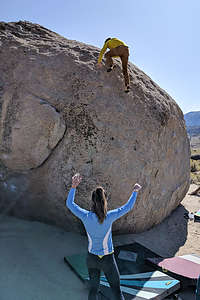 Celeste spotting Andrew in the ButtermilksMeanwhile, we were all gathered now in the parking lot for the main Buttermilks bouldering area, which has an amazing landscape - hundreds of huge boulders (or more technically, glacial erratics) strewn along a vast hillside with the snow-capped Sierra in the background.
Celeste spotting Andrew in the ButtermilksMeanwhile, we were all gathered now in the parking lot for the main Buttermilks bouldering area, which has an amazing landscape - hundreds of huge boulders (or more technically, glacial erratics) strewn along a vast hillside with the snow-capped Sierra in the background.
First, a very brief primer on bouldering. Bouldering is a form of rock climbing that does not use ropes because it is done on “boulders” that are not too high. To protect from injury, crash pads are placed on the ground to soften the climber’s fall. In addition to the pads, other climbers stand at the bottom with arms extended upward to catch or slow the climber down if he falls. However, in the Buttermilks, the boulders are pretty darn big, some as high as 45 feet.
Even though we, the “Outlaws,” had no plans of bouldering that day, it was a great place to just hang out, enjoy the scenery, and watch Andrew and Celeste puzzle out the “problems” they were working on. The word “problem” is used in bouldering because climbers often spend weeks and even months, working out all the moves to complete a particular bouldering route. The difficulty of a bouldering problem is graded on a scale from V0, being easiest, to V16.
 Andrew on Stained Glass in the ButtermilksToday, Celeste had two problems she wanted to work on. The first was a climb called Flyboy, an SDS V8 (SDS stands for doing it from a “sit down start”). Although much progress was made, she was still one move away from “sending” (completing) it. Andrew, who had done this one before, “sent” it again.
Andrew on Stained Glass in the ButtermilksToday, Celeste had two problems she wanted to work on. The first was a climb called Flyboy, an SDS V8 (SDS stands for doing it from a “sit down start”). Although much progress was made, she was still one move away from “sending” (completing) it. Andrew, who had done this one before, “sent” it again.
Near to Flyboy, there was a difficult V10 called Stained Glass, which Andrew had “sent” in the past. Just to ensure it was not a fluke, he “sent” it again. It was exciting to watch as it requires a big lunge with one hand to the top. It was like watching a well choreographed dance.
The final boulder problem of the day was a V7/8 called Junior’s Achievement, which Celeste got after a few tries - her hardest graded boulder problem to date.
They have both really become quite accomplished climbers during their 8 months of living in Bishop..
That evening, we drove 45 minutes up to Mammoth Lakes to the Black Doubt Brewery, where we enjoyed flights of beer. Afterwards we had dinner at the nearby, very popular Mammoth Tavern.
It was amazing how much colder it was in Mammoth Lakes, but then again, it is almost 4,000 feet higher. That’s what makes living in Bishop so cool. You don’t have to deal with much (if any) snow in the winter, but you can just drive 45 minutes to one of the best ski areas in the West.
I think they have chosen their new place of residence wisely.
Day 3 - Fishing in Mammoth Lakes
 Herb fishing the Owens RiverThe “Outlaws” were on their own today as Andrew and Celeste had to work, which they do remotely from their apartment. Their jobs are actually based out of San Francisco.
Herb fishing the Owens RiverThe “Outlaws” were on their own today as Andrew and Celeste had to work, which they do remotely from their apartment. Their jobs are actually based out of San Francisco.
We decided to drive back up to the Mammoth Lakes area to try to find a good place to fish. Much of the Owens River was pretty high and running fast, so we wanted to find a more gentle place to put a line in. We wound up finding a pretty section of the river near the Big Springs Campground, just off the Owens River Road in Mammoth.
 Aspen grove along Convict Lake TrailHerb and Paul got dressed in their matching waders, vests, and boots - they looked so cute - and headed down to the river. I was informed that my bright red down jacket would scare away any potential trout in this section of the river, so I went back to the car to get dressed in more subdued hues.
Aspen grove along Convict Lake TrailHerb and Paul got dressed in their matching waders, vests, and boots - they looked so cute - and headed down to the river. I was informed that my bright red down jacket would scare away any potential trout in this section of the river, so I went back to the car to get dressed in more subdued hues.
While Herb and Paul fished, Hilda and I hiked up the river about a mile until we were stopped by a fence with a No Trespassing sign blocking us from further exploration.
No fish were caught that day, but it still was fun hanging out along this pretty section of the Owens River.
On the way back to Bishop we stopped at Convict Lake, another beautiful Eastern Sierra alpine lake. It was absolutely stunning - crystal clear water, golden aspen trees along its shoreline, and the dramatic backdrop of the Sierra Nevada mountains.
 Along Fish Slough Road in the Volcanic TablelandsWe walked the 3-mile trail around the lake, stopping in a lovely grove of aspen trees lit by the low light of a beautiful autumn afternoon. It was so peaceful and even a bit spiritual. We found ourselves wanting to whisper to not disturb the serenity. It was absolutely lovely.
Along Fish Slough Road in the Volcanic TablelandsWe walked the 3-mile trail around the lake, stopping in a lovely grove of aspen trees lit by the low light of a beautiful autumn afternoon. It was so peaceful and even a bit spiritual. We found ourselves wanting to whisper to not disturb the serenity. It was absolutely lovely.
On the way back to Bishop, we took a quick detour onto the Fish Slough Road in the Volcanic Tablelands and just drove for a few miles. I think Herb was getting antsy to get the 4Runner off the beaten track and onto some dirt roads. We drove for 6.7 miles where our “Sierra Nevada Best Backcountry Drives” very correctly told us we would find petroglyphs. It was right. There they were, practically alongside the road.
This was definitely a road worth exploring in the future, but for now we had to get back for dinner at Andrew and Celeste’s.
Day 4 - Onion Valley
 One of the lovely alpine lakes along the hike to Kearsarge PassWe have really good kids. After 4 nights sleeping at their place, they still wanted us to stay longer. Okay, one more night, but we still did have to get out of the house all day so that they could work.
One of the lovely alpine lakes along the hike to Kearsarge PassWe have really good kids. After 4 nights sleeping at their place, they still wanted us to stay longer. Okay, one more night, but we still did have to get out of the house all day so that they could work.
Today I suggested we explore Onion Valley, a place that I had never heard of until reading a book that Andrew and Celeste had given me for Christmas entitled “Tales Along El Camino Sierra,” which is a collection of short stories that take you on a century-long journey along Highway 395 (the old El Camino Sierra).
The book contains 36 chapters, about 4 pages, each telling a tale about the people and/or places along this road that have made it so special. It was like eating a bag of potato chips - I kept saying “just one more” before being able to put the book down. I dogeared the pages of interesting places to explore, but they became so numerous that I created a Google Map with each of them as bullets.
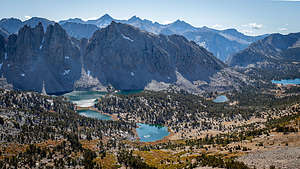 The view of Kearsarge Lakes Basin from the PassIn the early 1900s, the people along what is now Highway 395 realized what an incredibly beautiful place they lived in and wanted to share it with the world - and boost their economy as well. At the time, there was a nationwide campaign, called the Good Roads Movement, to develop paved roads in rural communities. The Inyo Good Road Club formed in 1910 in an effort to promote the beauty and recreational opportunities of Inyo County and obtain some of those federal dollars designated for building roads. Obviously they succeeded, and today Highway 395 is one of the most beautiful roads in the country.
The view of Kearsarge Lakes Basin from the PassIn the early 1900s, the people along what is now Highway 395 realized what an incredibly beautiful place they lived in and wanted to share it with the world - and boost their economy as well. At the time, there was a nationwide campaign, called the Good Roads Movement, to develop paved roads in rural communities. The Inyo Good Road Club formed in 1910 in an effort to promote the beauty and recreational opportunities of Inyo County and obtain some of those federal dollars designated for building roads. Obviously they succeeded, and today Highway 395 is one of the most beautiful roads in the country.
One of the ambitious road projects the forward-thinking and industrious people of Inyo County came up with in the 1950s was a road from the town of Independence up to and over Kearsarge Pass, almost 8,000 feet above the town, and down into what is today Cedar Grove in Kings Canyon National Park. Their ambitious plan was thwarted by the expansion of Kings Canyon National Park and the subsequent federal protection of the land east of Kearsarge Pass. However, they did manage to complete 13 miles of road, climbing 5,200 feet, to lovely Onion Valley with breathtaking mountain scenery - and wild onions, giving it its name.
 Hiking down from Kearsarge PassAlthough you can’t drive all the way to Kearsarge Pass, you can hike the remaining 5 miles (with 2,500 elevation gain) to it. We weren’t sure yet if we wanted to hike all the way up to the Pass -- I was a bit nervous about my recent bout with altitude sickness - or just do the shorter hike up to Flower and Matlock Lakes. We decided to play it by ear and see how we felt along the way.
Hiking down from Kearsarge PassAlthough you can’t drive all the way to Kearsarge Pass, you can hike the remaining 5 miles (with 2,500 elevation gain) to it. We weren’t sure yet if we wanted to hike all the way up to the Pass -- I was a bit nervous about my recent bout with altitude sickness - or just do the shorter hike up to Flower and Matlock Lakes. We decided to play it by ear and see how we felt along the way.
The trail did steadily climb for 5 miles, but it did so at a steady, reasonable grade. That plus the scenery which was beautifully distracting made our decision easy - we would continue on and up to the Pass.
At 4 mile, we began scanning the steep wall of rock ahead of us, trying to figure out where the Pass was and how our trail would get us there. But get it there it did, through a series of switchbacks that made the steep climb very doable. At the top we were greeted by a sign: Kearsarge Pass 11,760, Entering Kings Canyon National Park. The view from the Pass of the Kearsarge Pinnacles and Kearsarge Lakes of Kings Canyon was stunning.
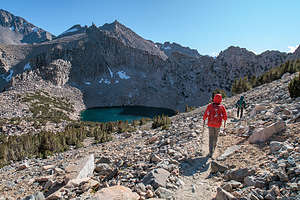 Hiking down from Kearsarge PassAlthough we were alone when we first got to the top, gradually more and more hikers joined us and had the same reaction to the view. Many of the people we met at the Pass were PCT hikers coming over the pass to resupply in the town of Independence. Wow! The hike we were doing today was just a resupply mission for them, with 0 miles progress on the PCT. They were going to hike all the way down to Onion Valley, hitchhike down to Independence, stock up, and then hike up to the Pass again. Made our hike feel a bit less impressive, but then again, we were probably twice or even thrice their age.
Hiking down from Kearsarge PassAlthough we were alone when we first got to the top, gradually more and more hikers joined us and had the same reaction to the view. Many of the people we met at the Pass were PCT hikers coming over the pass to resupply in the town of Independence. Wow! The hike we were doing today was just a resupply mission for them, with 0 miles progress on the PCT. They were going to hike all the way down to Onion Valley, hitchhike down to Independence, stock up, and then hike up to the Pass again. Made our hike feel a bit less impressive, but then again, we were probably twice or even thrice their age.
The hike down was pretty easy, a grade that was not as harsh on the knees as many downhill hikes can be. What a great hike!
This was our last night to stay with Andrew and Celeste, so rather than have our wonderful hosts cook for us again, we went out for dinner at the Yamatani Japanese Restaurant in Bishop.
Tomorrow we would be on our own. We had two choices of a route home - both of which were spectacular. North up 395 and through Tuolumne Meadows, or south on 395 through Lone Pine. Since we knew the northern route was colder and we would be sleeping in our truck, we decided to take the southern route.
Description
Bishop is my favorite town in the Eastern Sierra. It is located along US 395 between the towns of Mammoth Lakes and Big Pine. It lies at the northern end of the Owens Valley with the Sierra Nevada mountains to the east and the White Mountains to the west.
One of the town’s claims to fame is that it is the "Mule Capital of the World," holding a week-long festival each May called Bishop Mule Days. Part mule show, part test of skills, and part Wild West Show, this annual event has been attracting crowds for over its 47 year history, growing from a crowd of 200 in its early days to becoming an international world class event with more than 30,000 fans. Over the course of a week, more than 700 mules compete in 181 events including calf roping, steer roping, barrel racing, flat racing, carriage driving, team chariot racing, and even dressage.
The reason we go to Bishop is for the excellent rock climbing. The three major climbing areas in Bishop include:
The Owens River Gorge is a steep 10 mile long canyon just north of Bishop that is a very popular destination for rock climbing. With 416 sport-climbing and 52 trad routes it is California’s most concentrated sport climbing area. The climbing is on volcanic tuff and features edges, pockets and cracks. Although there is a full range of difficulty level, the best climbs are in the 5.10 to 5.11 range. The most popular walls are located in the Central Gorge – Warm Up Wall, the Pub, the Social Platform, and the Great Wall of China, which feature tons of 5.8 to 5.11 sport routes. Summers get a bit too hot to climb in the gorge.
Buttermilk Country, one of California’s premier bouldering destinations, is located southwest of Bishop along the western edge of the Owens Valley. These massive glacial erratic boulders sit in the foothills of the Sierra Nevada under an impressive backdrop of high peaks just a mere four miles to the west. There are 243 bouldering routes, many of which top out at over 20 feet.
The Volcanic Tablelands, another popular bouldering destination, lie just north of Bishop in an area where the floor of the Owens Valley rises abruptly, forming a 300 foot-high volcanic plateau. Along the southern tip of the plateau there are numerous canyons and washes containing thousands of boulders. The Happy Boulder area with 418 routes and the Sad Boulder area with 187 routes are the most popular. Because of its 4,500 foot elevation, the Volcanic Tablelands are climbable year round.
- 1 of 5
- next ›
Bishop location map in "high definition"
Javascript is required to view this map.
